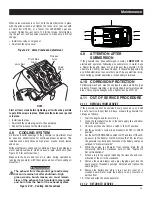
10
Based on this testing and the requirements of NFPA 37, Sec 4.1.4,
the guidelines for installation of the generators listed above are
changed to 18 inches (457mm) from the back side of the genera-
tor to a stationary wall or building. For adequate maintenance and
airflow clearance, the area above the generator should be at least
4 feet with a minimum of 3 feet at the front and ends of the enclo-
sure. This would include trees, shrubs and vegetation that could
obstruct airflow. See the diagram on the reverse of this page and
the installation drawing within the owner’s manual for details.
Generator exhaust contains DEADLY carbon monoxide gas. This
dangerous gas can cause unconsciousness or death. Do not place
the unit near windows, doors, fresh air intakes (furnaces, etc.) or
any openings in the building or structure, including windows and
doors of an attached garage.
If the AUTO/OFF/MANUAL switch is not set to
its OFF position, the generator can crank and
start as soon as the battery cables are con-
nected. If the utility power supply is not turned
off, sparking can occur at the battery posts and
cause an explosion.
1.12 THE
BATTERY
Do not dispose of the battery in a fire. The
battery is capable of exploding.
A battery presents a risk of electrical shock
and high short circuit current. The following
precautions are to be observed when working
on batteries:
• Remove the 7.5A fuse from the generator control
panel.
• Remove watches, rings or other metal objects.
• Use tools with insulated handles.
• Wear rubber gloves and boots.
• Do not lay tools or metal parts on top of the
battery.
• Disconnect charging source prior to connecting or
disconnecting battery terminals.
Do not open or mutilate the battery. Released
electrolyte has been known to be harmful to
the skin and eyes, and to be toxic.
The electrolyte is a dilute sulfuric acid that is
harmful to the skin and eyes. It is electrically
conductive and corrosive.
The following procedures are to be observed:
• Wear full eye protection and protective clothing.
• Where electrolyte contacts the skin, wash it off
immediately with water.
• Where electrolyte contacts the eyes, flush thor-
oughly and immediately with water and seek medi-
cal attention.
• Spilled electrolyte is to be washed down with an
acid neutralizing agent. A common practice is to
use a solution of 1 pound (500 grams) bicarbonate
of soda to 1 gallon (4 liters) of water. The bicar-
bonate of soda solution is to be added until the
evidence of reaction (foaming) has ceased. The
resulting liquid is to be flushed with water and the
area dried.
Lead-acid batteries present a risk of fire
because they generate hydrogen gas. The fol-
lowing procedures are to be followed:
• DO NOT SMOKE when near the battery.
• DO NOT cause flame or spark in battery area.
• Discharge static electricity from body before
touching the battery by first touching a grounded
metal surface.
Be sure the AUTO/OFF/MANUAL switch is set
to the OFF position before connecting the bat-
tery cables. If the switch is set to AUTO or
MANUAL, the generator can crank and start as
soon as the battery cables are connected.
Be sure the utility power supply is turned off
and the 7.5A fuse is removed from the genera-
tor control panel, or sparking may occur at the
battery posts as the cables are attached and
cause an explosion.
Servicing of the battery is to be performed or supervised by per-
sonnel knowledgeable of batteries and the required precautions.
Keep unauthorized personnel away from batteries.
See the Specifications section for the correct size and rating when
replacing the battery. Have these procedures performed at the
intervals specified in the “Service Schedule.” A negative ground
system is used. Battery connections are shown on the wiring dia-
grams. Make sure the battery is correctly connected and terminals
are tight. Observe battery polarity when connecting the battery to
the generator set.
1.13 BATTERY
REQUIREMENTS
See the Specifications section for correct battery size and rating.
1.14 BATTERY
INSTALLATION
Fill the battery with the proper electrolyte fluid if necessary and
have the battery fully charged before installing it.
Before installing and connecting the battery, complete the follow-
ing steps:
1. Set the generator's AUTO/OFF/MANUAL switch to OFF.
2. Turn off utility power supply to the transfer switch.
3. Remove the 7.5A fuse from the generator control panel.
Battery cables were factory connected at the generator (Figure
1.9). Connect cables to battery posts as follows:
4. Connect the red battery cable (from starter contactor) to the
battery post indicated by a positive, POS or (+).
5. Connect the black battery cable (from frame ground) to the
battery post indicated by a negative, NEG or (—).
6. Install the battery post covers (included).
NOTE:
General Information
Summary of Contents for 10 kW
Page 31: ...29 Notes ...
Page 32: ...30 Installation Diagrams Drawing 0J3244 B ...
Page 33: ...31 Drawing 0J3244 B Installation Diagrams ...
Page 71: ...69 Notas ...
Page 107: ...105 Remarques ...













































